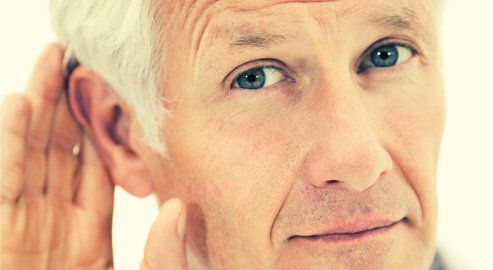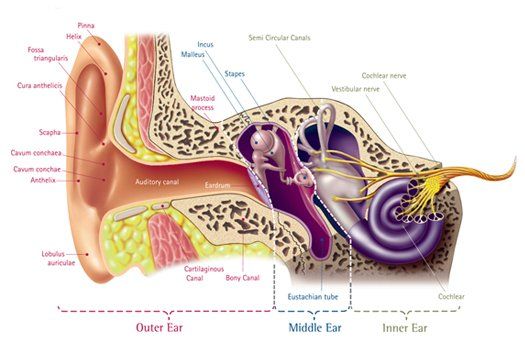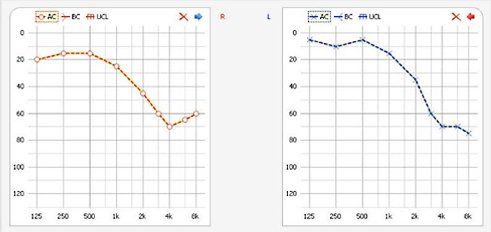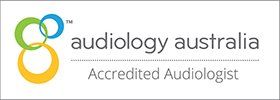Hearing Test
Knowledge is Power
Understanding Hearing Loss
Hearing Loss Prevention
How's Your Hearing?
- Mild 21-40dB – soft sounds may be difficult to distinguish.
- Moderate 41-60dB – conversational speech is hard to hear, especially if there is background noise (such as a television or radio).
- Severe 61-90dB – conversational speech can’t be heard.
- Profound cannot hear sounds softer than 91db – almost all sounds are inaudible. Most people with profound hearing loss benefit from a hearing aid, while some don’t.

Deafness can be simply defined as the inability to hear.
Hearing impairment may be more specifically described according to its degree:
Hearing losses are also generally categorised according to whereabouts along the hearing ‘pathway’ they occur.
A conductive loss occurs when something interferes with sound travelling between the outer and inner ears (e.g., infection). These are usually medically or surgically treatable.
A sensorineural loss results from damage to the cochlea (the organ of hearing) or the auditory nerve. It may cause reduced sound levels, distortion and other problems. Hearing aids or cochlear implants are often recommended.

The most significant cause of hearing loss in Australia is exposure to excessive noise. Hearing impairment may be more specifically described according to its degree:
Hearing loss can also be acquired through illness, accident, exposure to certain drugs and chemicals, or as part of the normal ageing process.
Causes in the Outer Ear
Typical problems with the outer ear include ear wax plugs and infections of the auditory canal. Usually, addressing these problems is very easy. But it is important to act quickly in order to avoid hearing damage.
Causes in the Middle Ear
Inflammation, fluid behind the eardrum, perforations of the eardrum and otosclerosis (a stiffening of the bones in the middle ear) are the most common problems to interfere with middle ear function. Most outer and middle ear problems can be addressed effectively with medication or surgery. If this is not possible, permanent hearing loss can be compensated with a hearing aid in most cases.
Causes in the Inner Ear
The majority of hearing issues concern the inner ear. The most common cause is the natural aging process. But loud noise, taking some types of medication, or skull fractures can also have a negative influence on a person’s hearing ability. These influences damage the fine hair cells and affect the transmission of signals to the auditory nerves. Usually, inner ear hearing loss cannot be addressed medically. However, this type of hearing loss can be corrected with a hearing aid in most cases.
Hearing loss caused by an outer or middle ear defect is called conductive hearing loss. Damage to the inner ear, is called sensorineural hearing loss. If both types occur together, the condition is called mixed hearing loss.
- Beware of recreational sources of hazardous noise like firearms, firecrackers, power tools, music concerts, dance clubs, sporting events, motorcycles, motorboats, snowmobiles, powerboats, and “boom cars”.
- The risk for hearing loss due to exposure to noise is especially high among factory and heavy industry workers, transportation workers, military personnel, construction workers, miners, farmers, firefighters, police officers, musicians, and entertainment industry professionals.
- If you have to raise your voice to shout over the noise to be heard by someone within an arm’s length away, that noise could be a serious risk to your hearing. You can prevent hearing loss by removing yourself from situations where noise is excessive or by using ear plugs to protect your ears.
- You hear ringing or buzzing (tinnitus) in your ears after exposure to noise.
- You notice that you can hear people talking, but you have difficulty understanding them, after exposure to noise.
- You experience “fullness” in your ears after leaving a noisy area.
- If you work in an at-risk occupation, check with your employer to make sure that your jobsite has an effective program to adequately protect your hearing, meeting federal or state regulations.
- Wear hearing protection, such as earplugs or earmuffs, consistently when using loud equipment at work or at home. Foam earplugs are available at your pharmacy, earmuffs can be purchased at sporting goods or safety equipment stores, and specialized hearing protection is available from hearing clinics.
- Limit exposure to noisy activities at home. Monitor your listening level and how long you are listening to personal listening devices (like MP3 players, such as iPods). Encourage your children to use their headphones conservatively. Consider investing in higher quality earphones that block out background noise, to help you moderate your listening levels in noisier places. Note: being able to overhear your child’s headphones is not a good way to tell if they are listening too loud! If you can hear it, their music might be too loud, but just because you can’t hear it, that doesn’t mean the levels are ok.
- Buy quieter products (compare dB ratings and ask for low-noise products).
- Keep an “eye” on your hearing – see a hearing health professional routinely for hearing testing, or if offered through your employer, ensure you know your hearing test results and track it year-to-year.
Excessive noise exposure damages the delicate hair cells in the inner ear, not dissimilar to the effect of age on the ear (accelerated “wear and tear”). This damage often results in permanent, sensorineural hearing loss and tinnitus (ringing of the ears). Hazardous noise exposures can occur on the job, but also in common recreational activities. Hearing loss prevention thus requires diligence and sensitivity to situations where hearing can be put at risk:
Warning Signs
Be alert to some of these warning signs, which could suggest that you’ve been exposed to hazardous noise:
Remember, even though you might have experienced these symptoms temporarily in the past, your hearing might not always “recover,” leaving you with a permanent and regrettable hearing problem.
What You Can Do to Protect Your Hearing
An Ounce of Prevention
Be alert to risks of hazardous noise in your life. Since prevention of hearing loss is so critical, make sure that your family (especially children), friends, and colleagues are aware of the hazards of noise and how they can protect themselves. Remember, one-third of permanent hearing loss is preventable with proper hearing loss prevention strategies.
- A Ringing Sensation in the Ears (Tinnitus)
- People Complain That You Talk Too Loudly
- You Often Have to Ask People to Repeat Themselves
- You Find It Hard to Follow Conversations, Especially in Crowded or Noisy Environments
- Friends and Family Complain About the TV Volume
- You Feel like Everyone Is Mumbling!

Some signs that you may need to have your hearing checked include:

An audiogram is a graphic representation of your hearing ability. An Audiogram shows you and your hearing professional how well you can hear, weather it be good, or perhaps not so good. During a hearing test, your hearing is checked at different frequencies. The result is recorded as a characteristic audiogram curve.
Hearing tests check a person’s ability to hear the loudness and pitch of sounds. The softest sounds you can hear are charted on a graph (audiogram) to help pinpoint the severity and causes of hearing problems. Hearing loss is measured in decibels (dB), which measure intensity, and pitch in hertz (Hz), which measures frequency. Hearing loss is usually described as mild, moderate, severe or profound. Hearing is tested differently in children and adults.
The simplest way to test hearing is called pure tone audiometry. This involves listening to a range of beeps and whistles, called pure tones, and indicating when you can hear them.
Air conduction is when hearing is measured by pure tones played through headphones. The sounds go via the air, down the ear canal, through the middle ear and to the very delicate cochlea in the inner ear.
Bone conduction tests the sensitivity of the cochlea by placing a small vibrator on the mastoid bone behind the ear. Sounds presented this way travel through the bones of the skull to the cochlea and hearing nerves, bypassing the middle ear.
The results of both air conduction and bone conduction hearing tests are marked on an audiogram which can tell us whether the loss is sensorineural or conductive.
Tympanometry is not a hearing test, but a test of how well the middle ear system is functioning and how well the eardrum can move. A small rubber tip is placed in the ear and a little air is pumped into the outer ear canal. If there is a problem in the middle ear, it may show up on this test. The results of tympanometry can indicate the location of a blockage that is causing the hearing loss and if medical treatment will help.
Speech Discrimination Tests
When hearing is damaged, it is usually not just the volume or quantity of sound heard that is lost. Often the quality of the sound is also distorted. The amount of distortion can be measured using speech discrimination tests. Poor speech discrimination means that voices are distorted and not loud enough.

Several methods can be used to test hearing, depending on a child’s age, development, and health status. That will usually involve a combination of behavioural and physiological tests.
Behavioral tests involve careful observation of a child’s behavioral response to sounds like calibrated speech and pure tones.
The behavioral response might be an infant’s eye movements, a head-turn by a toddler, placement of a game piece by a preschooler, or a hand-raise by a grade-schooler. Speech responses may involve picture identification of a word or repeating words at soft or comfortable levels. Very young children are capable of a number of behavioral tests.
If you have any concerns regarding your child‘s hearing, we strongly recommend making an appointment with a qualified audiologist.

